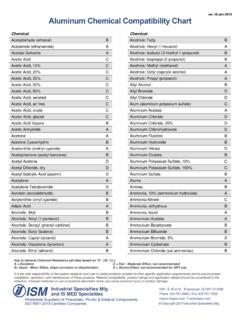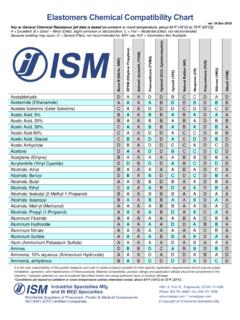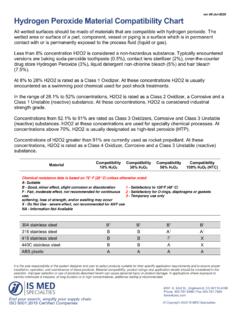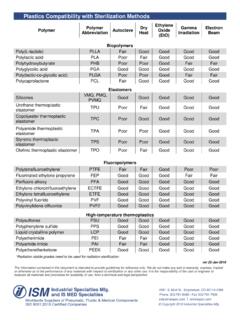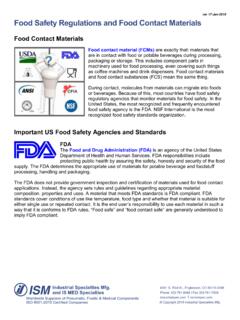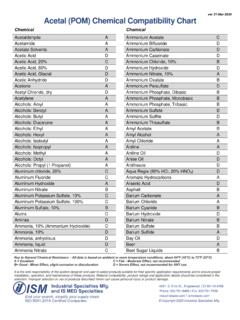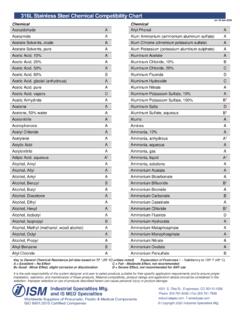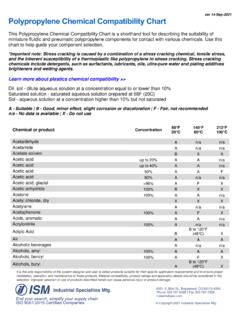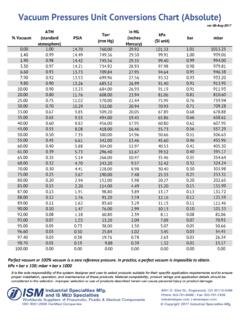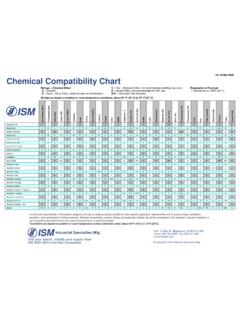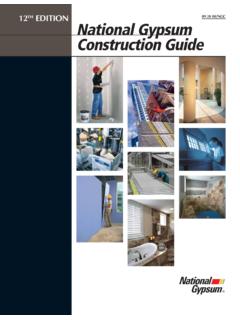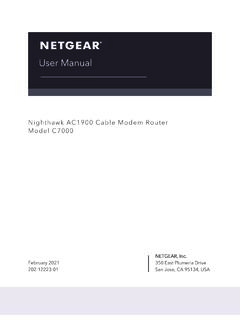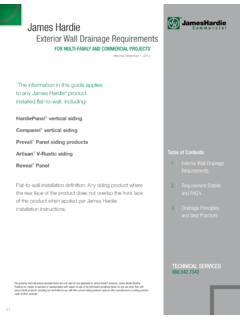Transcription of MESH and MICRON SIZES - Industrial Spec
1 Ver 11-Mar-2020 4091 S. Eliot St., Englewood, CO 80110-4396 Phone 303-781-8486 I Fax 303-761-7939 Copyright 2020 Industrial Specialties Mfg. Industrial Specialties Mfg. and IS MED Specialties ISM mesh and MICRON SIZES What is a MICRON ? MICRON is the measure of length most frequently used to describe tiny particle SIZES . The term MICRON is actually a commonly used shorthand for micrometer (American spelling) or micrometre (international spelling). The official symbol for the MICRON or micrometer is m, sometimes simplified as um. A MICRON is defined as one-millionth of a meter, a little more than one twenty-five thousandth of an inch. Note: ISM offers fluid, gas and air flow management components some of which contain filter mesh as a component part.
2 ISM does offer mesh itself and is unable to source or provide it. What does mesh size mean? mesh size usually is referring to the mesh number (a US measurement standard) and its relationship to the size of the openings in the mesh and thus the size of particles that can pass through these openings. Figuring out the mesh number is simple. All you do is count the number of openings in one linear inch of screen. This count is the mesh number. A 4- mesh screen means there are four little square openings across one inch of screen. A 100- mesh screen has 100 openings per inch, and so on. As the number indicating the mesh size increases, the size of the openings and thus the size of particles captured by the screen decreases. Higher mesh numbers = smaller particle SIZES .
3 It is very important to remember that mesh size is not a precise measurement of the mesh opening size. This is because screens can be made with different materials with different thicknesses of strands or wire. The thicker the strands, the smaller the openings that a particle can pass through, and vice versa. Also keep in mind that mesh is a two-dimensional sheet and the actual 3D shapes of particles vary dramatically. A good example of this is the diameter of a hair versus its length. Particles can also be elastic amalgams or clumps of mixed materials that can deform and squeeze through mesh openings. How fine do screens get? This depends on the thickness of the wire or strand used to make the mesh . Most ISM flow control components do not contain filter screens any finer than 500 mesh .
4 The primary reason for this is that as the mesh number rises, the space between the wires or strands becomes smaller. At some point the mesh number becomes so high that the percentage of open area is too low to be useful. This point is usually somewhere between 450 and 700 mesh depending on the diameter of the wire or filament used. Note: Beyond 325 to 400 mesh , particle size is normally described only in microns. US mesh * Microns Inches Millimeters 35 500 40 400 45 354 50 297 60 250 70 210 80 177 100 149 120 125 140 105 170 88 200 74 230 63 270 53 325 44 400 37 450 32 500 25 635 20 *Values are based on the American National Standard for Industrial Wire Cloth (American Standard ASTM - E 11).
5 Some MICRON size comparisons ver 11-Mar-2020 4091 S. Eliot St., Englewood, CO 80110-4396 Phone 303-781-8486 I Fax 303-761-7939 Copyright 2020 Industrial Specialties Mfg. Industrial Specialties Mfg. and IS MED Specialties ISM PARTICLE SIZES in MIRONS of COMMON MATERIALS bacteria to 60 beach sand 100 to 2000 cayenne pepper (ground) 15 to 1000 cement dust 3 to 100 cinnamon (ground) 70 to 200 clay to 2 coal dust 1 to 100 coffee (ground) 5 to 400 concrete dust 3 to 100 copier toner to 15 corn starch to dust (atmospheric) to 40 dust (household) to 100 dust mites 100 to 300 eye of a needle 1230 flour (wheat - milled) 25 to 212 gelatin powder 5 to 90 giardia cysts 8 to 14 ginger (ground) 25 to 40 human hair 70 (40 to 120) human vision (lower limit) 40 mustard (ground) 6 to 10 oil smoke to 1 pet dander to 100 pollens 2 to 200 red blood cells 6 to 8 salt (table salt) 100 to 300 sand (beach) to 2,000 sand (fine)
6 125 to 250 silt 2 to 50 skin flakes to 10 smoke (oil) to 1 smoke (wood) to 3 spider web 2 to 3 spores (mold) 3 to 12 spores (plant) 3 to 100 spray dried milk powder 30 to 80 sugar (granulated) 250 to 500 sugar (icing) 20 to 24 sugar (powdered) 60 talcum powder (ground talc) to 50 tea dust 8 to 300 tobacco smoke to 4 viruses to white blood cells 6 to 20 yeast cells 1 to 50 ver 11-Mar-2020 4091 S. Eliot St., Englewood, CO 80110-4396 Phone 303-781-8486 I Fax 303-761-7939 Copyright 2020 Industrial Specialties Mfg. Industrial Specialties Mfg. and IS MED Specialties ISM US STANDARD and TYLER mesh Approximate Equivalent mesh Count US Sieve mesh Number1 Tyler Equivalent Mesh2 Typical Nominal Wire Diameter4 Typical Nominal Sieve Size Opening4 mm inch mm inch 2 - 2 mesh 3 - 3 mesh 3 No.
7 3 3 mesh 4 No. 4 4 mesh 5 No. 5 5 mesh 6 No. 6 6 mesh 7 No. 7 7 mesh 8 No. 8 8 mesh 10 9 mesh 12 No. 12 10 mesh 14 No. 14 12 mesh 16 No. 16 14 mesh 18 No. 18 16 mesh 20 No. 20 20 mesh 24 No. 25 24 mesh 28 No. 30 28 mesh 32 No. 35 32 mesh 35 No. 40 35 mesh 42 No. 45 42 mesh 48 No. 50 48 mesh 60 No. 60 60 mesh 65 No. 70 65 mesh 80 No. 80 80 mesh 100 100 mesh 115 No. 120 115 mesh 150 No. 140 150 mesh 170 No. 170 170 mesh 200 No.
8 200 200 mesh 250 No. 230 250 mesh 270 No. 270 270 mesh 325 No. 325 325 mesh 400 No. 400 400 mesh 4353 No. 450 - 5003 No. 5005 - 6323 No. 6355 - 1. US sieve numbers differ from Tyler mesh in that they are arbitrary numbers. 2. Tyler Equivalent Mash or Tyler mesh Size is the number of openings per linear inch of mesh . 3. These mesh numbers are calculated approximations. 4. Values are based on ASTM E11-17, ISO 565-1990 and ISO 3310-1:2016 sieve specifications. ASTM E11-17 ISO 565-1990 ISO 3310-1:2016 5. These sieves are not standard series sieves but are in common use. ver 11-Mar-2020 4091 S.
9 Eliot St., Englewood, CO 80110-4396 Phone 303-781-8486 I Fax 303-761-7939 Copyright 2020 Industrial Specialties Mfg. Industrial Specialties Mfg. and IS MED Specialties ISM mesh and MICRONS FAQs How do you convert mesh opening size to microns? It is possible to calculate an approximate mesh opening size for plane weave mesh with square openings. Both the wire or strand diameter and the distance between the centers of two adjoining strands must be known to do this. Filter mesh manufacturers provide the mesh opening size or the mesh s percent of open area or both. If a mesh opening size is provided in inches, it can be easily converted to microns. One MICRON is one-millionth of a meter and 1 inch = millimeters. What is mesh number?
10 mesh number indicates the number of filaments or wires per linear inch of fabric or wire filter cloth. As mesh number increases, the size of the mesh openings decreases. mesh number is not a precise measurement of particle size because of variations in the size of the wire or strands used in the screen. The mesh scales used to classify particle SIZES in the US are: US Sieve Series and Tyler mesh Size. What is US Standard mesh ? US Standard mesh , also called US Standard Sieve is a series of screen sieves generally used to classify granular material by particle size. US Standard mesh numbers are also more broadly used to describe the size of screen, strainer and filter mesh woven from monofilament or metal wires. US Standard Sieve uses arbitrarily assigned numbering and is based on ASTM E11-17.
